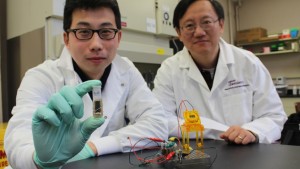Research out of the Institut National de la Recherche Scientifique (INRS) has yielded a novel micro-supercapacitor that has reportedly reached an energy density 1,000 times greater than current electrochemical capacitors.
This unmatched energy storage performance was made possible through a new electrode, producing density levels comparable to that of current lithium-ion micro-batteries.
Applications of this new technology could range from small electronics to autonomous sensor networks, opening the door to better water quality and air pollution monitoring.
“The extent of the electrode’s surface and the presence of pores of various sizes are key to a large storage capacity. We designed this new 3D electrode using an electrochemical process to synthesize a very porous gold structure. Ruthenium oxide, a pseudocapacitative material featuring high electrical conductivity and very good cyclability, was then inserted into the structure, resulting in unsurpassed energy density. For this type of application, component sizes are reduced to a few square millimeters, making it possible to use such expensive materials,” said Daniel Guay, ECS member and co-author of the study.



